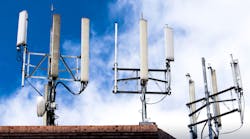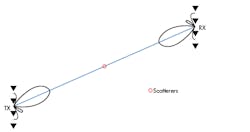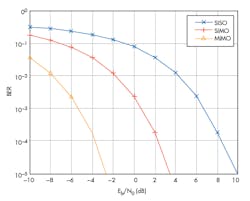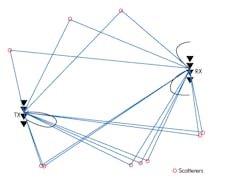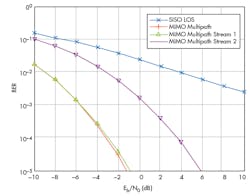Algorithms to Antenna: Beamforming to Improve Signal-to-Noise Levels and Achieve Higher Channel Capacity with MIMO Systems
Let’s look at some basics related to array design, beamforming, and spatial multiplexing. These topics will be important in the drive for higher channel capacity and will provide a good starting point for future blog topics. 5G systems will need to serve many users with the highest possible data rates, but system designs still have to fit within the constraints of radiated power limits and operating budgets defined at the onset of your projects. Improving the signal-to-noise ratio (SNR) is key to improving data rates. In addition, serving more users is possible only if all channel resources within an array are reused.
Antenna arrays are required in 5G wireless communication systems, just as they are for radar and electronic warfare (EW) systems. In this blog, we will look at how arrays make it possible to reuse the spatial information in the system to improve the coverage.
For ease of discussion, we put together a simple example to show how to quantify how an array configuration improves SNR. (The full example shows how performance improves by exploiting the redundancy across the multiple transmit and receive channels.) To simplify the analysis, we use a 4-element uniform linear array (ULA) with spacing between elements equal to one half the wavelength. You could extend the number of elements or else use different array geometries in your own analysis.
In our example, we first use a line-of-sight channel. You can see in Fig. 1 that with pre-steering (beamforming), SIMO systems offer a performance advantage over the SISO case. It shouldn’t be a surprise that when the transmit array and the receive arrays are both used to steer the beam, the resulting gain also further improves. We can use much larger MIMO arrays to improve gain of the transmitted or received signals for a specific, desired area. This steering, or beamforming on the transmit and receive side, can increase SNR while also eliminating interference from undesired sources.
1. Shown are BER improvements for SISO, SIMO, and MIMO systems.
It is important to understand that the challenges facing 5G systems go beyond SNR. To achieve higher channel capacity, we also look at the more challenging case where multipath fading environments exist, beyond the simpler case of line-of-sight paths.
There are alternative ways to use the channel using spatial multiplexing. The idea behind spatial multiplexing is that a MIMO system, with a multipath channel and a rich scatterer environment, can send multiple data streams simultaneously across the channel. The goal of spatial multiplexing is less about increasing the SNR and more about increasing the information throughput.
With spatial multiplexing, we can separate the channel matrix into multiple modes so that data streams sent from different elements in the transmit array can be independently recovered from the received signal. To achieve this result, each data stream is precoded before the transmission and then combined and recovered after the reception.
The information received by each receive array element is simply a scaled version of the transmit array element, which means it behaves like multiple orthogonal subchannels within the original channel. The first subchannel corresponds to the dominant transmit and receive directions, so there is no loss in the diversity gain. In addition, it is now possible to use other subchannels to carry information.
Intelligence can be applied to the allocated power per element. The example in the link above includes a simple illustration of this concept, but research is still very much active in this area.
With this backdrop, the next question is, how do your array design choices impact your system-level performance? The answer really depends on the nature of the channel. That is, arrays can be used to either improve the SNR via the array gain or the diversity gain, or improve the capacity via the spatial multiplexing.
Take a look at the summary plot in Fig. 2 for the multiscatter channel. While the second stream doesn’t provide a gain as high as the first stream (because it uses a less dominant subchannel), the overall information throughput is improved. Again, this concept can easily extend to many more channels.
2. Shown are BER improvements in multipath scenarios versus LOS.
Hopefully you find this blog and the below resources helpful. Feel free to contact me on this site or by e-mail.
Learn more about topics covered in this blog post:
- Hybrid Beamforming for Massive MIMO Phased Array Systems (white paper): Learn how to design hybrid beamforming in massive MIMO antenna arrays for 5G, using features available with MATLAB and Simulink.
- Improve SNR and Capacity of Wireless Communication Using Antenna Arrays (example): See how implementing antenna arrays can help improve the SNR and capacity of a wireless link.
- MIMO-OFDM Precoding with Phased Arrays (example): Learn how phased arrays are used in a MIMO-OFDM communication system employing beamforming.
See additional 5G, radar, and EW resources, including those referenced in previous blog posts.
